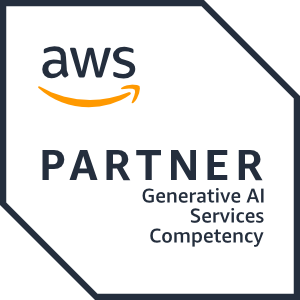











Recognized by AWS for our deep expertise in designing, deploying, and scaling GenAI solutions using services like Amazon Bedrock, SageMaker, and the latest foundation models.
From large enterprises to high-growth startups, we’ve successfully delivered AI-driven innovation tailored to diverse business needs.
We bring ready to deploy GenAI blueprints for Fintech, Education, Retail, eCommerce and more, speeding up your time to value and innovation.
With teams on the ground in country in the UAE and KSA, and deep understanding of local business and compliance needs, we support you every step of the way in the Middle East.

Discover where GenAI fits into your business and explore high-impact use cases.

Evaluate your data, systems, and strategy for GenAI integration.

Build quick PoCs and scale them into secure, production-ready solutions.

Integrate intelligent agents to transform your software development lifecycle.

Leverage text, image, video, and audio models using Amazon Bedrock, SageMaker, and the latest foundation models like the Nova family.

From backend to frontend, we design, build, and deploy scalable AI applications with intuitive interfaces and robust cloud-native architecture.
Generative AI is a type of AI that can create new content and ideas, including conversations, stories, images, videos, and music. Like all AI, generative AI is powered by ML models—very large models that are pre-trained on vast amounts of data and commonly referred to as foundation models (FMs). Recent advancements in ML (specifically the invention of the transformer-based neural network architecture) have led to the rise of models that contain billions of parameters or variables. FMs can perform so many more tasks because they contain many parameters that make them capable of learning complex concepts.
The size and general-purpose nature of FMs make them different from traditional ML models, which typically perform specific tasks, like analyzing text for sentiment, classifying images, and forecasting trends.
To achieve each task, for each ML model, customers need to gather labeled data, train a model, and deploy that model. With foundation models, instead of gathering labeled data and training multiple models, you use the same pretrained FM to adapt several tasks. FMs can also be customized to perform domain-specific functions that are differentiating to their businesses, using only a small fraction of the data and compute required to train a model from scratch.
There are three reasons that explain foundational models’ success:
The transformer architecture: The transformer architecture is a type of neural network that is efficient, easy to scale, and parallelize, and can model interdependence between input and output data.
In-context learning: Showing potential on a range of applications, from text classification to translation and summarization, this new training paradigm provides pre-trained models with instructions for new tasks or just a few examples instead of training or fine-tuning models on labeled data. Because no additional data or training is needed and prompts are provided in natural language, models can be applied right out of the box
Emergent behaviors at scale: Growing model size and the use of increasingly large amounts of data have resulted in what is being termed as “emerging capabilities.” When models reach a critical size, they begin displaying capabilities not previously present.

Read how Integra helped Diglossia with AWS Generative AI solutions which helped improve student outcomes and measures literacy progress over time.

Read how Integra helped Data Inflexion, a startup specializing in creating libraries and tools for real estate and property listing website developers.
